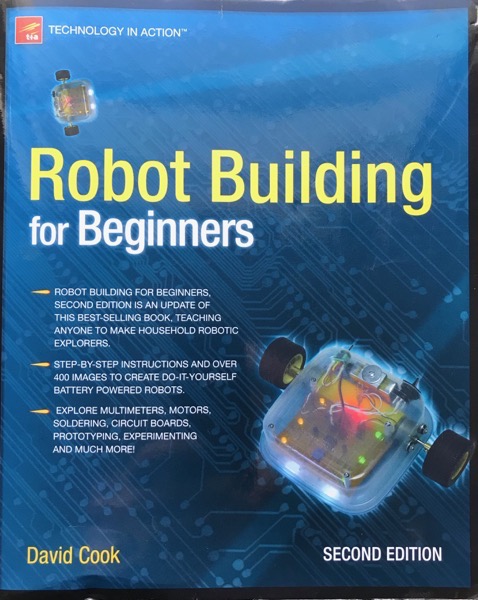In an earlier part of my life I spent my working days writing device drivers for things like printer mechanisms, disc drives and so on. What they all seemed to have in common was that they turned a motor. I was missing turning motors so when I came across a book “Robot Building for Beginners” by David Cook I pricked up my ears. The book leads you from knowing nothing about electronics to building a robot which will trundle along following a line drawn on the ground. This looked like fun so I thought I’d build it.

The technology that the book uses to construct the robot is purely analogue. The line is detected with photoresistors and the motors are simple DC motors with no steppers in sight. What makes the book stand out is the superb way the author explains how and why electronic components work. He explains through examples about resistors and voltage dividers, through LEDs and capacitors, and from comparators to motors. Now I didn’t start from scratch with my knowledge but it seems to be a extremely good way to learn from scratch. And you get a cool robot at the end. Even if it is made from a carry-out box.
I’d built the robot and it worked but the motors were turning too fast. Slowing down a motor is harder than it sounds as all the easy options — adding resistors for example have big drawbacks. I added a PWM-based control to the motor speed controlled by pushing buttons. Here’s the PIC code: http://fletch.scot/code/line-follow.zip. This took a little while as although I had spent my time turning motors I don’t remember using PWM, so I had to learn it. I was using an online copy of the book on the learning part of the IEEE website. I went back to SkillSoft to read the next chapter of the book and the IEEE had stopped using SkillSoft and I could no longer read the book. Luckily I found a paper copy of the book for sale online and bought that so I could continue the project. But it reminded me to not rely on things in the cloud.
Here’s a video of the first run of the robot in action.
Line following robot first run 480p IMG_1145.mov
As you can see the robot needs to be made more robust. One thing I learned from making it is that my usual technique for attaching wires to pins using wires taken from ribbon cable is not good enough (despite copious application of hot glue). This leads to lots of tweaking of connectors. So before I show the robot to my grandsons I’ll have to find a better connection method or they will destroy it with their youthful exuberance.
